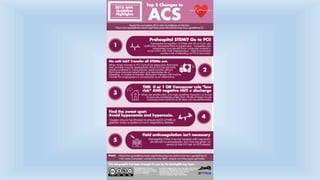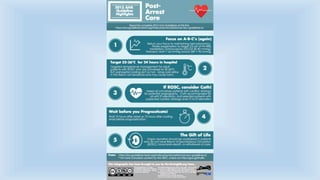Approach to bradycardia
- 1. ADULT BRADYCARDIA: AN OVERVIEW Faez Baherin Emergency Physician ED Hospital Melaka
- 2. Outline • Introduction and definition • Bradycardia algorithm at a glance • Stable vs unstable bradycardia • Drugs in bradycardia • Transcutaneous pacing • Take-home message • New updates 2015
- 3. Introduction • heart rate of <60 beats per minute. • when bradycardia is the cause of symptoms, the rate is generally <50 beats per minute, which is the working definition of bradycardia used in ACLS • focuses on management of clinically significant bradycardia (ie, bradycardia that is inappropriate for the clinical condition)
- 5. Approach to bradycardia • ABC • provide supplementary oxygen if hypoxemia • hypoxemia is a common cause of bradycardia, initial evaluation of any patient with bradycardia should focus on signs of increased work of breathing and oxyhemoglobin saturation • Attach a monitor to the patient • evaluate blood pressure • establish IV access • 12-lead ECG to better define the rhythm • Assess stable vs unstable
- 6. Stable bradycardia • asymptomatic or minimally symptomatic patients do not necessarily require treatment • unless there is suspicion that the rhythm is likely to progress to symptoms or become life-threatening (eg, Mobitz type II second- degree AV block in the setting of acute myocardial infarction)
- 7. Unstable bradycardia • identify signs and symptoms of poor perfusion and determine if those signs are likely to be caused by the bradycardia • acute altered mental status • ischemic chest discomfort • acute heart failure • hypotension • signs of shock
- 8. Drugs in unstable bradycardia : Atropine • first-line drug, reverses cholinergic-mediated decreases in heart rate • improved heart rate, symptoms, and signs associated with bradycardia. • considered a temporizing measure while awaiting a transcutaneous or trans venous pacemaker for patients with symptomatic sinus bradycardia, conduction block at the level of the AV node, or sinus arrest
- 9. Drugs in unstable bradycardia : Atropine • 0.5 mg IV every 3 to 5 minutes, maximum total dose of 3 mg • Avoid relying on atropine in type II second-degree or third-degree AV block, preferably treated with TCP or β-adrenergic support as temporizing measures while the patient is prepared for transvenous pacing
- 11. Drugs in unstable bradycardia : • dopamine, epinephrine, and isoproterenol are alternatives when a bradyarrhythmia is : • unresponsive to or inappropriate for treatment with atropine, or • as a temporizing measure while awaiting the availability of a pacemaker Dopamine: 2 to 20 mcg/kg/min Or Adrenaline: 2-10 mcg/min
- 12. Transcutaneous pacing • initiate TCP in unstable patients who do not respond to atropine • Immediate pacing might be considered in unstable patients with high- degree AV block when IV access is not available • If the patient does not respond to drugs or TCP, transvenous pacing is probably indicated
- 13. Transcutaneous pacing • Attach pads • Select mode : fixed or demand • Select rate 60-80 • Select energy : step up / step down method • Look for electrical capture then feel for mechanical capture • Increase energy by 5mAmp • Transcutaneous pacing may be uncomfortable for the patient. Sedation should be considered.
- 14. TCP stimulus does not work through the normal cardiac conduction system but by a direct electrical stimulus of the myocardium. Therefore, a “captured" compex will resemble a PVC. Electrical capture is characterized by a wide QRS complex, with the initial deflection and the terminal deflection always in opposite directions
- 16. • Attach pads • Select mode : fixed or demand • Select rate 60-80 • Select energy : step up / step down method • Look for electrical capture then feel for mechanical capture • Increase energy by 5mAmp • Transcutaneous pacing may be uncomfortable for the patient. Sedation should be considered.
- 18. Take-home message • Memorize the algorithm • Know your drugs • Know how to operate TCP machine • Early referrals for further management – TCP is only TEMPORARY
Editor's Notes
- During transcutaneous pacing, pads are placed on the patient's chest, either in the anterior/lateral position or the anterior/posterior position. The anterior/posterior position is preferred as it minimizes transthoracic electrical impedance by "sandwiching" the heart between the two pads. The pads are then attached to a monitor/defibrillator, a heart rate is selected, and current (measured in milliamps) is increased until electrical capture (characterized by a wide QRS complex with tall, broad T wave on the ECG) is obtained, with a corresponding pulse. Pacing artifact on the ECG and severe muscle twitching may make this determination difficult. It is therefore advisable to use another instrument (e.g. SpO2 monitor or bedside doppler) to confirm mechanical capture. A randomized controlled trial in which atropine and glycopyrrolate were compared with TCP showed few differences in outcome and survival, although the TCP group obtained a more consistent heart rate.363 In a study evaluating the feasibility of treatment with dopamine as compared with TCP, no differences were observed between treatment groups in survival to hospital discharge.370























